Portovenere
Find out the secrets of this seafront town!
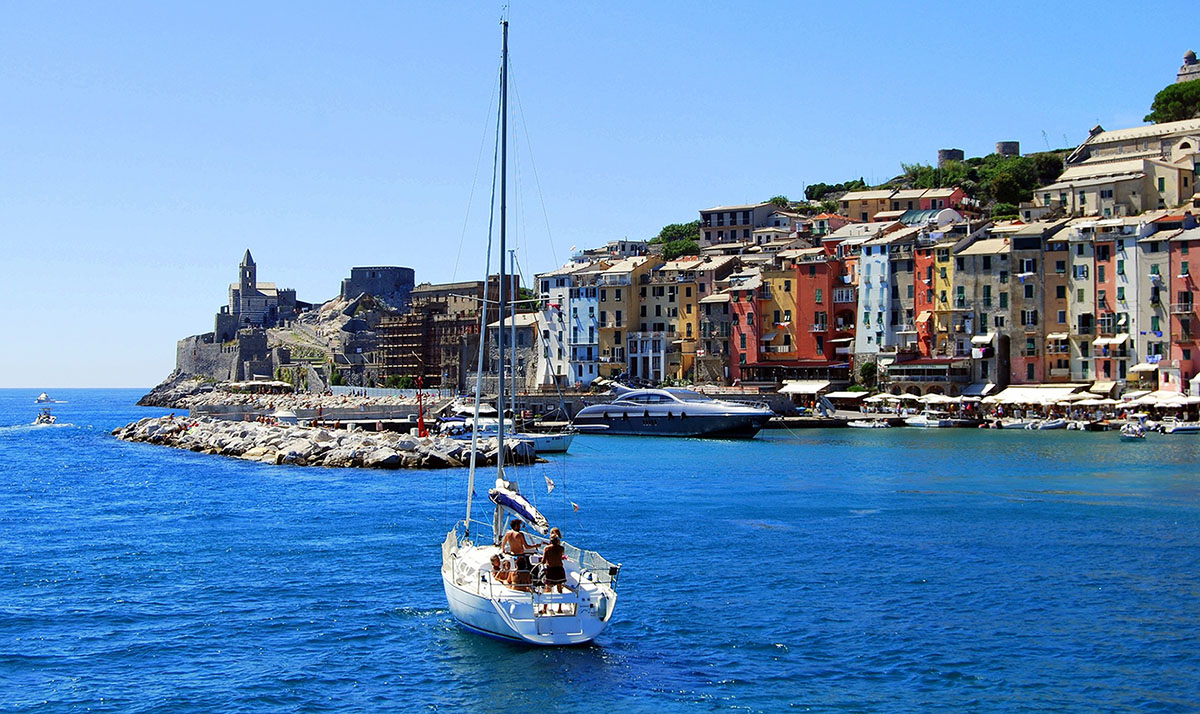
What to see in Portovenere
Welcome to the Riviera Ligure di Levante (Eastern Ligurian Riviera)
Are you planning to spend your holidays in Liguria? Looking to discover our region’s most evocative and beautiful areas? If so, you can’t miss the eastern Ligurian Riviera! Stretching from the eastern side of Genoa province to the province of La Spezia, it encompasses a 130 km-long coastline rich in seafront villages, picturesque inlets, coves, islands, and splendid gulfs. There are countless wonderful places to visit in the eastern Ligurian Riviera, and the Golfo dei Poeti, i.e. the Gulf of Poets, is definitely one of these.
The Golfo dei Poeti
The Gulf of la Spezia, also known as the Gulf of Poets, is a wide inlet of the sea that stretches westward from the right after Bocca di Magra, near Punta Bianca and Punta Corvo, to Portovenere. Among the most poetic corners of the Mediterranean Sea, it offers enchanting villages such as Tellaro and Fiascherino, natural parks, seaside towns like Lerici and Portovenere. Not to mention the wide La Spezia coastline, with its harbor and preeminent Naval Academy, and looks onto the sea and enchanting islands of the archipelago.
Porto Venere
Where is Portovenere? This charming gem of a town is encased between the sea and rocky coastline right at the end of the Gulf of Poets, just a few dozen meters from Palmaria Island. The Church of San Pietro, the symbol of the village, stands guard over the western tip of the promontory that borders the Gulf of La Spezia.
Universally acclaimed as a genuine masterpiece resulting from an incredibly harmonious blend of nature and architecture, Portovenere, along with the Cinque Terre and Palmaria, Tino, and Tinetto Islands, was proclaimed a UNESCO World Heritage Site in 1997.
What to see in Portovenere
Portovenere, steeped in charm and enchantment, has haunted poets in search of their muse, and their voice, for centuries: Dante, Botticelli, Petrarch, Byron, Shelley, and Montale, to name but a few, have all been captivated by these evocative lands.
In addition to enjoying the area’s natural marvels, its rocky coastlines, cliffs, islets, caves, and beaches, tourists can visit the historic center to discover the local centuries-old cultural heritage. The Roman Villa of Varignano, the Doria Castle, the Church of San Pietro, and the Church of San Lorenzo are some of the town’s most inspiring landmarks. The historic center is also perfect for a carefree walk.
To give you an idea of what there is to enjoy, we’ve selected some of the most famous and fascinating sights in Portovenere. We want to tell you about them through both photos and words.
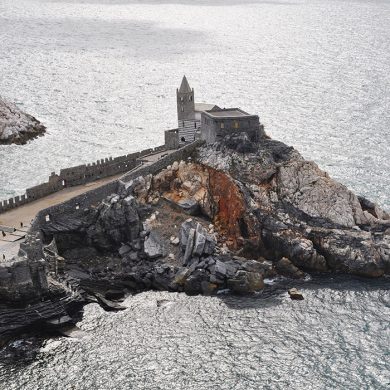
San Pietro Church
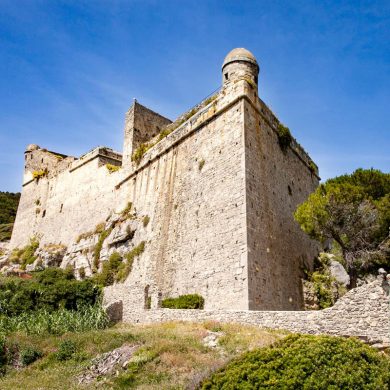
Doria Castle
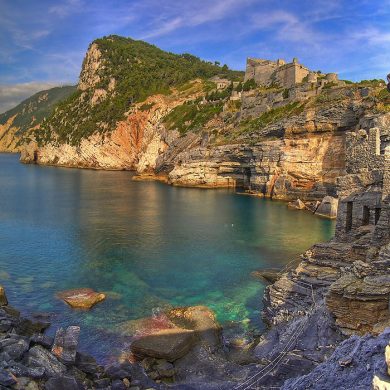
Byron’s Grotto
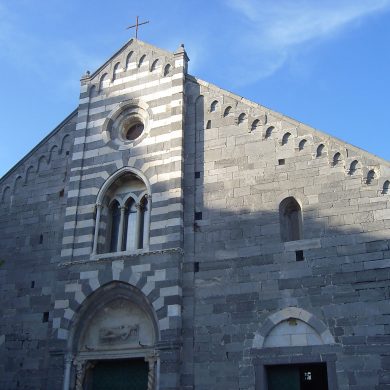
San Lorenzo Church
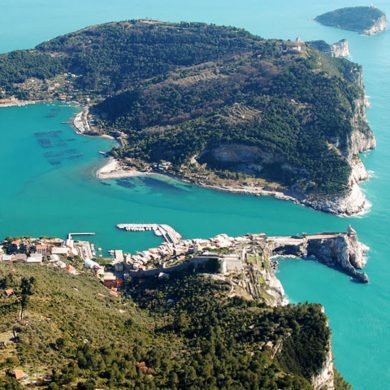
Palmaria Island
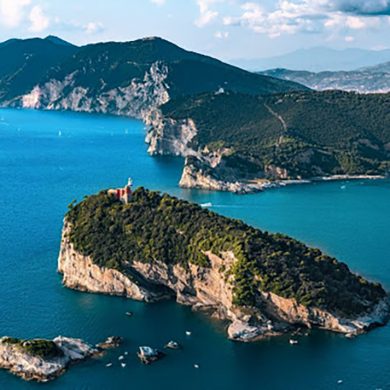
Tino and Tinetto Islands
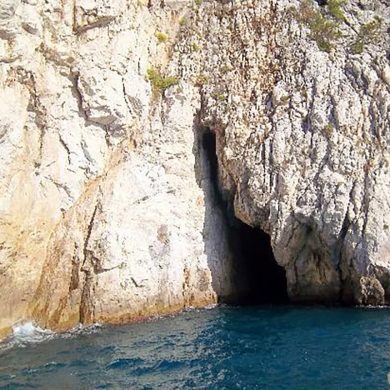
Blue Grotto
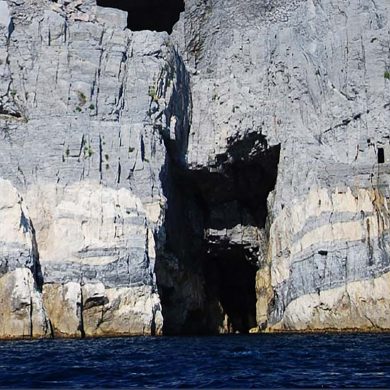
Volcanic Grotto
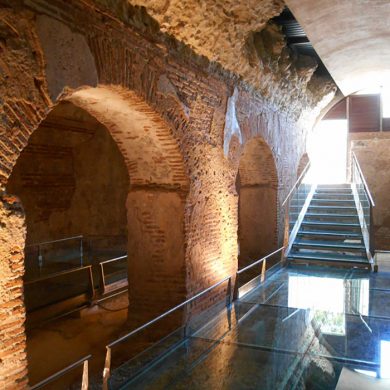
Villa Romana del Varignano
Sights to see in Portovenere
Portovenere landmarks
Browse the list below to get an overview of what you can see and do in Portovenere. All sights listed are easy to reach from Restaurant Il Timone.
The old town
Located at a brief walking distance from our restaurant, Portovenere’s Porta Romana, surmounted by the Torre Capitolare, is the gateway to the old town. Over the door, you can see the town’s coat of arms and a large shrine that houses the “Madonna Bianca”, a fresco that dates back to 1494. Exploring the town center, you’ll discover the Carugi, tiny typical streets lined with fascinating workshops and stores filled with local products and crafts.
Church of San Lorenzo / Sanctuary of the Madonna Bianca
San Lorenzo, Portovenere’s second most important church, rises just 350 meters from Il Timone. Also known as Sanctuary of the Madonna Bianca (“White Virgin Mary”), it was built by the Magistri Antelami, a group of itinerant carpenters from Lombardy, between 1116 and 1130, and boasts a lovely Romanesque façade. It was dedicated to the Virgin Mary in 1399, when, as the story goes, she interceded to save the village from the plague. The Madonna Bianca is the patron saint of the village of Portovenere and is celebrated yearly on August 17.
Doria Castle
The Doria Castle is a can’t-miss sight located steps away from Il Timone. Commissioned by the Republic of Genoa in 1161, it is a majestic pentagon-shaped fortress that dominates and protects the village from above. Open for visits every day from 10 am to 6 pm, the Doria Castle is a remarkable example of the military architecture of the Genoese Republic, and also displays vestiges of the changes made in the 1500s and during the Napoleonic era.
San Pietro Church
Setting off from our restaurant and walking southwest for less than 10 minutes, you’ll find one of Portovenere’s most symbolic buildings, the Church of San Pietro. Mentioned in a poem by the famed Italian poet Eugenio Montale, it is a veritable jewel of Ligurian religious architecture. Standing proudly on the rocks overlooking the gulf, it was erected in the 13th century, in Genoese Gothic style, and still comprises the remnants of a 5th-century early Christian church. The atmosphere is striking and unique, starting with the outside: from the small colonnaded portico that faces the church one sees incredible views of the sea and western coastline down to the Cinque Terre. Inside, lulled by the sounds of the sea, one can appreciate the elegant simplicity of an austere setting. Visit it early in the morning, or at sunset, to see the inside enhanced by the beautiful light.
Villa romana del Varignano
Portovenere’s most stunning sight if you’re a visitor who loves ancient history. This ancient Roman dwelling (domus) dating back to the 2nd century B.C., is located in the archaeological area in the Le Grazie neighborhood, 1.7 km from Il Timone.
Visiting this Roman villa allows full immersion in ancient history, local heritage, and agriculture in the Latin era: the villa, in fact, houses Liguria’s most ancient standing oil mill!
Natural marvels to admire in Portovenere
Portovenere’s many attractions include natural beauties as well as human-crafted ones. Byron’s Grotto, the Blue Grotto, and Palmaria, Tino, and Tinetto Islands are among these.
Byron’s Grotto
Byron’s Grotto, “Grotta di Lord Byron” in Italian, lies nestled below the rocky spur where the Church of San Pietro stands. This sea cavern is so evocative that it has inspired fascinating anecdotes. As the story goes, the English poet Lord Byron loved to come here and write. Historic records show that Byron was actually here in 1822 when he sailed his boat from Pisa to Liguria to stay with Mr. and Mrs. Shelley at the Villa Magni, in Lerici. While there on the Riviera, he broke a record swimming for about 8 km from one side of the gulf to the other, precisely from San Terenzo to Portovenere.
Portovenere Regional Nature Park
The Portovenere Regional Nature Park is a protected area in the Province of La Spezia, in Liguria. This marine reserve encompasses the islands of the archipelago and provides many opportunities for swimming and nature-focused walks.
The Blue Grotto and the Volcanic Grotto of Cala Grande are two of Portovenere’s most renowned natural sights. Both are located on Palmaria Island.
The Blue Grotto lies within a crag on the island, and can only be reached by boat. We recommend touring it at sunset, to enjoy the unforgettable light effects enhanced by the sunlight. The Volcanic Cave of Cala Grande owes its name to the way it is shaped, reminiscent of a lava flow, and there is a freshwater spring inside.
The viewpoints
The scenery is definitely one of Portovenere’s most exceptional features. The town is studded with incredible viewpoints offering spectacular vistas of its natural wonders and human-crafted landscape.
Set off from Il Timone and walk along the waterfront via Calata-Doria. You’ll soon be in Piazza Spallanzani, from where you can enjoy breathtaking views of the Gulf of La Spezia and Palmaria Island.
One of Portovenere’s scenic viewpoints is dedicated to Mother Nature and enhanced by a bronze sculpture by Lello Scorzelli, a Neapolitan sculptor. The statue portrays Mother Nature dominating the landscape that unwinds below.
Located some 30 meters away from Lord Byron’s Grotto the Arpaia Promontory is another great spot to enjoy the view.
Very exciting, and perfect to take impressive photos. Approaching the church you’ll capture views of the blue sea through small windows carved in the stone of the city walls, and climbing up you’ll find an enchanting terrace interspersed with Roman columns.
Looking for a viewpoint close to Il Timone? Don’t miss the Terrace on the Marina! All you need to do is take a short walk after lunch, and you’ll find yourself surrounded by beauty. You’ll see Palmaria Island on the left, and the village, with its colorful tower-houses, on your right. These buildings that seem to lean one onto the other are a distinctive feature of this end of the Ligurian coast.